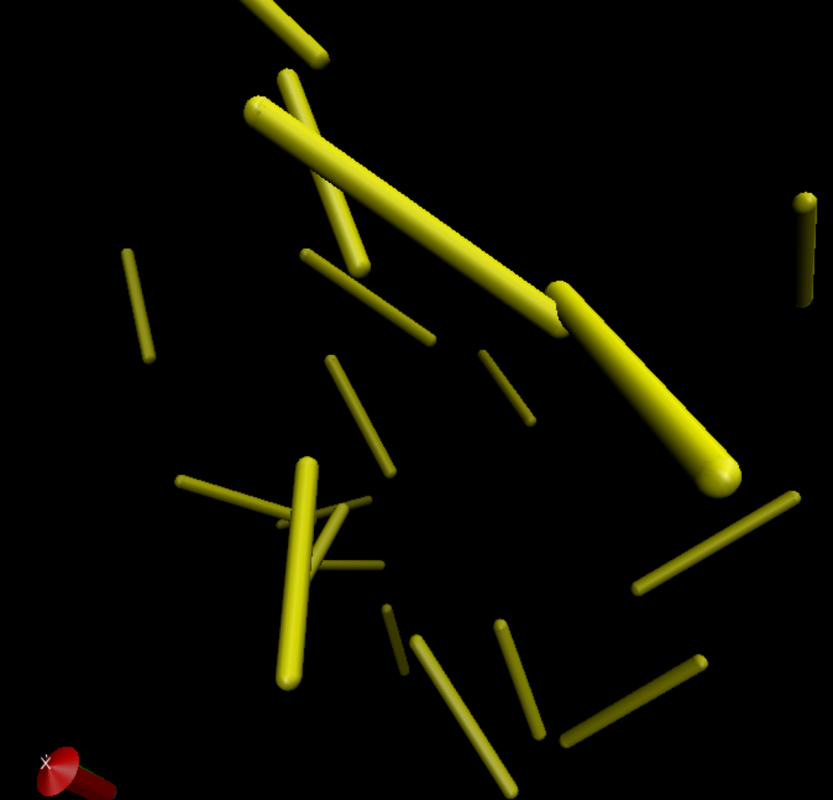Hi,
I used the 3D shortest distance between two line segments algorithm at this website: http://geomalgorithms.com/a07-_distance.html#dist3D_Segment_to_Segment
This function in Python is checking if two capsules intersect. I checked the algorithm from the website and it seems to work. I tried implementing an epsilon to help with floating point error, but I don't think I did it correctly. Help would be much appreciated.
def check_intersection(particle1,particle2):
decimal.getcontext().prec = 100
epsilon = 2**-52 #implement epsilon
small_num = 0.00000001 #number to check if they're closely parallel
u = particle1.get_s() #s1
v = particle2.get_s() #s2
p0 = particle1.get_p1_position() #P0
q0 = particle2.get_p1_position() #Q0
w = np.array([p0[0]-q0[0], p0[1]-q0[1], p0[2]-q0[2]]) #distance from 2 particles from their p1's
a = u[0]**2 + u[1]**2 + u[2]**2 #dot product of u*u. Always >=0
b = u[0]*v[0] + u[1]*v[1] + u[2]*v[2] #dot product of u*v.
c = v[0]**2 + v[1]**2 + v[2]**2 #dot product of v*v. Always >=0
d = u[0]*w[0] + u[1]*w[1] + u[2]*w[2] #dot product of u*w
e = v[0]*w[0] + v[1]*w[1] + v[2]*w[2] #dot product of v*w
D = (a*c)-b**2 #always >=0
#Set all to defaults
sc = sN = sD = D #sc = sN / sD, default sD = D >= 0
tc = tN = tD = D #tc = tN / tD, default tD = D >= 0
if D**2 < small_num: # checks if SCs are parallel
sN = 0.0 # force using point P0 on segment S1
sD = 1.0 # to prevent possible division by 0.0 later
tN = e
tD = c
else: # get the closest points on the infinite lines
sN = (b * e) - (c * d)
tN = (a * e) -(b * d)
if sN < 0.0:
sN = 0.0
tN = e
tD = c
elif sN > sD: # sc > 1 => the s=1 edge is visible
sN = sD
tN = (e + b)
tD = c
if tN < 0.0: # tc < 0 => the t=0 edge is visible
tN = 0.0
# recompute sc for this edge
if -d < 0.0:
sN = 0.0
elif -d > a:
sN = sD
else:
sN = -d
sD = a
elif tN > tD: # tc > 1 => the t=1 edge is visible
tN = tD
# recompute sc for this edge
if (-d + b) < 0.0:
sN = 0.0
elif (-d + b) > a:
sN = sD
else:
sN = (-d + b)
sD = a
# division to get sc and tc
if abs(sN) < small_num:
sc = 0.0
else:
sc = sN / sD
if abs(tN) < small_num:
tc = 0.0
else:
tc = tN / tD
# difference of 2 closest points
dP = np.array( [w[0] + (sc * u[0]) - (tc * v[0]), w[1] + (sc * u[1]) - (tc * v[1]), w[2] + (sc * u[2]) - (tc * v[2])] )
# dP = w + np.multiply(sc,u) - np.multiply(tc,v) #S1(sc) - S2(tc)
close_d = (math.sqrt(dP[0] ** 2 + dP[1] ** 2 + dP[2] ** 2) ) # closest distance b/w 2 lines
# check if distance <= radius * 2, if so, INTERSECTION!
diff = abs( close_d - (2*S_RADIUS) )
if(diff <= epsilon):
return True
else:
return False





